Goodbye to Monarch Butterfly

Source: Texas Butterfly Ranch
November 21, 2021
The Numbers
Every day, up to 150 species may go extinct. 150 species. The Monarch butterfly is one of 138,300 species considered to be endangered. A species is considered to be endangered when its population has dropped between 50 and 70 percent, meaning over 130,000 species of animals all over the world have dropped over half of their population size.
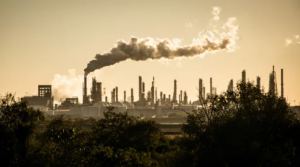
Of this number, almost 7,000 of them are listed as critically endangered. This means that they are at the most risk of going extinct in the near future. And the numbers only go up from there.
Scientists know of around two million species living on Earth currently, but they believe there may be up to 100 million species total. According to these scientists, the yearly extinction rate is anticipated to be between 0.01 and 0.1% of all species per year. This means, using the lowest number possible, between 200 and 2,000 species go extinct each year. Or, using scientists’ predicted numbers, 10,000 and 100,000 species go extinct each year. These numbers serve as a reminder of the coming future for the animal kingdom.
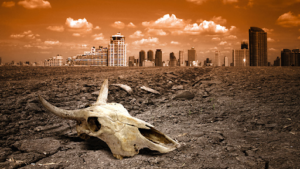
A recent article by the New York Times states that over 20 extinctions were recently documented by U.S Officials. In this article, an interview with Bridget Fahey, the supervisor for species classification for Fish and Wildlife Services, concludes that each of the 20+ species speaks for the steady loss to global biodiversity and possibly the extinction of millions of species within the next few decades. These recent extinctions included species of birds, fish, plants, and many other animals, all driven by human repercussions such as “farming, logging, mining, and damming”. Now, an even bigger problem is putting all species at risk of extinction; climate change.
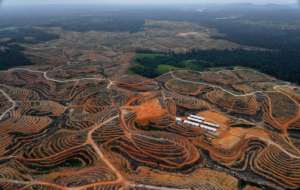
Extinction Coming in Waves
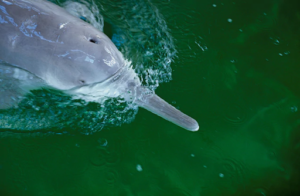
When naming endangered species, one may only think of listing land animals. However, aquatic animals are just as, if not more, in danger as the rest of the world. As of now, there are only five known river dolphin species in the world. Four of the five species are endangered and one is critically endangered, if not extinct already. River dolphins are at a high risk as they reside in densely populated areas of the world and are prone to threats by the damming of rivers for electricity generation according to Edge of Existence. But river dolphins are not the only underwater species being affected by human impact.
Leatherback sea turtles are the largest of all living turtles in the world, and the National Oceanic and Atmospheric Administration says that they are at high risk for extinction because of declining global population size due to human impacts. According to the NOAA site, their global population has decreased by about 40% in the past three generations.
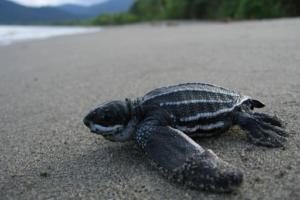
This is due to many threats posed against them, but the biggest one is most likely the direct harvest of their eggs. Sea turtle egg poaching is a large threat against all sea turtles, but the Leatherback is reaping most consequences. According to the World Wildlife Fund, the Pacific female sea turtle population is estimated to be about 2,300. Although not all Leatherback populations are decreasing, an effort should be made to preserve this unique species.
Blue whales are the largest animals on the planet. Weighing up to 200 tons, they are truly one of Earth’s most extraordinary creatures. However, Blue whales are yet another marine species considered to be endangered. Ship strikes, fishing gear, and habitat loss are all threats posed to Blue whales every day. Without Blue whales, the ocean environment would change drastically. Being the highest on the ocean food chain, they maintain the marine environment. Blue whale populations may be in even more danger due to climate change, however. Warmer waters are expeditiously altering the habitats of Antarctic krill, which is the Blue whale’s largest source of food. Without this food source, it is likely that Blue whales will become more endangered and possibly even extinct. A solution is desperately needed to not only protect Blue whales but the rest of the ocean as well.
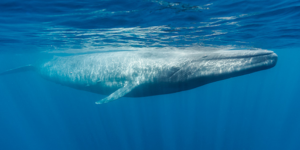
Loss of a Giant
In 2012, the last Pinta Giant tortoise, named “Lonesome George”, died at the estimated age of about 100 years old. Pinta Giant tortoises were driven to extinction by hunting, like many other animals of today’s extinction list. For years, biologists hoped that George would be able to beget offspring by breeding him with a similar species of tortoise. But after thirteen years and two prospective mates, all thirteen eggs that were produced were infertile. On June 24, 2012, George was found dead by his keepers due to natural causes.
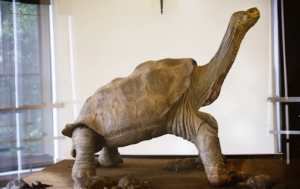
Although 100 years seems to be a long and healthy lifespan, his death shocked his caretakers. The Pinta Giant tortoise often lived to be around 200, so George died at a younger age. The story of Lonesome George is all too common in the animal world: one final individual carrying out its final days, and animal enthusiasts around the world can only wait for the species to be declared extinct.
The Northern White Rhino endured a similar story to Lonesome George. Sudan, the last male Northern White Rhino, passed on March 19, 2018. This was a tragedy for the Rhino conservation community, as his death leaves two female Northern White Rhinos; his daughter and his granddaughter, according to BBC News.
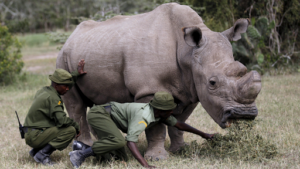
The article includes quotes from an official at a zoo Sudan had inhabited until 2009. One quotation, in particular, stands out among the rest of the interview; “His death is a cruel symbol of human disregard for nature,” It is a common occurrence that endangered animals are not cared about until it is too late, and if society were to change before the Northern White rhinos were driven down to one last male ancestor, it is likely they would still be alive today. Unfortunately, this change by society is something that is rarely seen by the animal world.
Tigers, as an entire species, are now on the critically endangered list and are at severe risk of extinction. Of all subspecies of tigers, there are just under 4,000 total tigers left in the wild today. There are various reasons why tigers are so endangered, but the main causes consist of deforestation and overhunting. Deforestation is currently progressing at the alarming rate of 47,000 square kilometers, or around 29,000 square miles, per year. This rate not only affects tigers but thousands of other species of animals as well. Initially, nine subspecies of tigers existed in the world, however, four are endangered, one is critically endangered, one is extinct in the wild, and three are fully extinct. There are currently between 7,500 and 10,000 tigers left in the entire world. Without enough conservation efforts, tigers will likely go extinct in the near future. Action needs to be taken to save this striped species.
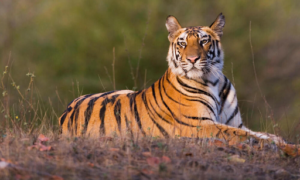
Endangerment in the Air
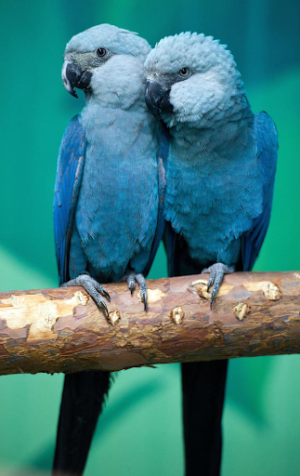
Yet another species extinct in the wild is the Spix’s macaw. With only around 160 individuals left in the world, the Spix’s macaw is a small, blue macaw species notorious for its attention in the animated movie “Rio”. According to the Associated for the Conservation of Threatened Parrots, or the ACTP, the Spix’s macaw was driven by human impact on this population problem. The destruction of its habitat combined with the illegal trafficking of the bird led to the species needing immense measures in order to be populated in the wild once again. This beautiful species of birds is one of many examples of how extinction not only affects animals wandering leafy forests and grasslands, but also the animals that soar high above us.
A Hawaiian species of forest bird, called “Honeycreepers”, has also been impacted by extinction due to climate change.
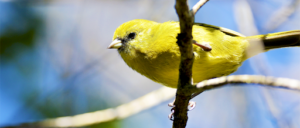
Although once had over 50 subspecies, the colorful birds are now down to around 17. They have long, curved beaks that allow them to drink nectar from flowers. Due to climate change’s impact on weather, plants and bees especially have faced monumental complications. Honeycreepers have also felt the impact of climate change, and there are many more birds facing the same reality.
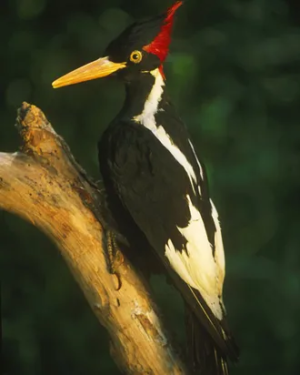
One of the more well-known bird extinctions was of the Ivory-billed woodpecker. In 1967, the woodpecker was listed as extinct; however, in 2004, a sighting of the remarkable species was recorded. Gene Sparling, a kayaker and avid searcher of the bird, claimed to have seen the bird in an Arkansas swamp. After the sighting, two more searchers flew to Arkansas to look for the woodpecker as well. An article in the New York Times says “On Day 2, paddling in their kayaks, they were getting ready to stop for lunch when suddenly a big bird flew right in front of them. ‘Tim and I both yelled ‘Ivory-bill!’ at the same time,’ Mr. Harrison recalled. In doing so, they scared the bird away.” Unfortunately, a recent species assessment declared the bird to be extinct once again, as the woodpecker was never officially found. The Ivory-bill was another beautiful, innocent species taken away from the globe due to human repercussions.
Destroying the Beauty of Earth
The monarch butterfly is the most commonly known butterfly species. Their orange and black wings fluttering in the blue sky is an image almost everyone can picture in their minds. However, these butterflies are currently facing endangerment due to threats such as deforestation and harsh weather conditions caused by climate change. Hotter temperatures due to climate change are another important factor in the decrease in monarch populations. According to an article by CNN, California’s monarch butterfly population was around 148,000 in 2017. But by the end of 2018, the population had dropped 86% to around 20,500. This dramatic drop in population size is a disappointment to many, as a loss such as this and many others will make the world duller. Scientists estimate that monarch butterflies may be extinct in the next 20 years. Without a change, this species and many others will go extinct in the near future.
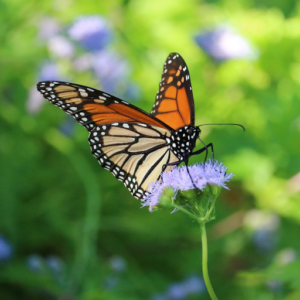
Global diversity is what makes Earth so unique and beautiful. One cannot imagine a world without a variety of sea life, striped tigers, and colorful birds. But unfortunately, without a change, this may be the bleak future in store for society. Organizations such as the World Wildlife Fund, the National Wildlife Federation, and Wildlife Conservation Society are all working to help these animals and many others to have another chance to thrive in the wild. Fighting against climate change, pollution, and deforestation will eliminate some of the largest threats to endangered animals. If society wants a lasting vivid world of wildlife, change needs to happen.
